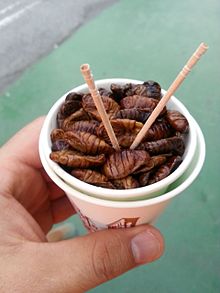Beondegi
Appearance
 | |
| Course | Street food |
|---|---|
| Place of origin | Korea |
| Associated cuisine | Korean cuisine |
| Main ingredients | Silkworm pupae |
| Similar dishes | Nhộng tằm |
| Korean name | |
| Hangul | 번데기 |
|---|---|
| Revised Romanization | beondegi |
| McCune–Reischauer | pŏndegi |
| IPA | [pʌn.de.ɡi] |
Beondegi (번데기), literally "pupa", is a Korean street food made with silkworm pupae.[1] It is usually sold from street vendors. The boiled or steamed snack food is served in paper cups with toothpick skewers.[2]
Canned beondegi can also be found in grocery stores and convenience stores.
Silkmoth pupae are also eaten in a number of other cultures.
- In Assam, they are boiled for extracting silk and the boiled pupae are eaten directly with salt or fried with chili pepper or herbs as a snack or dish.[3]
- In China, street vendors sell roasted silkmoth pupae.
- In Japan, silkworms are usually served as a tsukudani (佃煮), i.e., boiled in a sweet-sour sauce made with soy sauce and sugar.
- In Vietnam, this is known as con nhộng.
- In Thailand, silkworm pupae (ดักแด้ไหม, /dàk.dɛ̂ː.mǎj/), usually deep-fried, are often sold at open markets. They are also sold as packaged snacks.
- Silkworms have also been proposed for cultivation by astronauts as space food on long-term missions.[4]
Gallery
-
Beondegi sold by a street vendor
-
Canned beondegi
Wikimedia Commons has media related to Silkworms as food.
References
- ^ Pettid, Michael J. (2008). Korean Cuisine: An Illustrated History. London: Reaktion Books. p. 173. ISBN 978-1-86189-348-2.
- ^ Kraig, Bruce; Sen, Colleen Taylor, eds. (2013). Street Food around the World: An Encyclopedia of Food and Culture. Santa Barbara, CA: ABC-CLIO. p. 320. ISBN 978-1-59884-954-7.
- ^ "10 Weird Foods in India - Eri polu". February 2013.
- ^ Choi, Charles Q. (13 January 2009). "Care for a Silkworm With Your Tang?". ScienceNOW Daily News. Archived from the original on 25 February 2011. Retrieved 14 January 2009.



